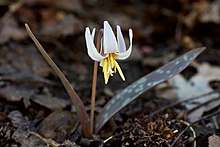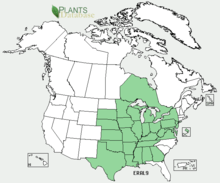Erythronium albidum
Erythronium albidum, the white fawnlily or white trout lily, is a small herbaceous flowering plant in the lily family.[2][3][4][5] It is native to eastern North America, from southern Quebec and southern Manitoba south to Georgia and Texas.[6]
| Erythronium albidum | |
|---|---|
 | |
| Scientific classification | |
| Kingdom: | Plantae |
| Clade: | Tracheophytes |
| Clade: | Angiosperms |
| Clade: | Monocots |
| Order: | Liliales |
| Family: | Liliaceae |
| Genus: | Erythronium |
| Species: | E. albidum |
| Binomial name | |
| Erythronium albidum | |
 | |
| Synonyms[2] | |
|
Erythronium albidum var. coloratum Sterns | |
It produces short, slender stems 10–15 cm (4–6 in) tall, which bear two oblong leaves on each stem. The leaves are lanceolate, 8–16 cm (3 1⁄4–6 1⁄4 in) long and 3–4 cm (1 1⁄4–1 1⁄2 in) broad, dark green and covered with a mottled pattern of purple blotches. At the end of the stem, the plant produces a white, lily-like flower 3–4 cm (1 1⁄4–1 1⁄2 in) in diameter, with six yellow stamens. The flowers are bent downward, and elongate with age. It blooms in mid to late spring.[4]
The plant is mostly found in large groups on the forest floor, often in areas following ground disturbance. Its preferred growing conditions are in part sun to mostly shade and deep, moist loamy soils.[4]
It is also known as adder's tongue, dog's-tooth violet, serpent's tongue, trout lily, deer tongue, and yellow snowdrop.
Folklore and uses
.jpg)
European settlers considered it to have similar properties to meadow saffron (Colchicum autumnale), and white fawnlily was often used as a substitute for it. The plant was listed in the Pharmacopoeia of the United States from 1820-1863 as a treatment for gout.
Some believe that wounds will be healed if the plant is soaked in cold water, then removed and wrapped it in cloth and applied to a wound or bruise. It is left there until the bundle is warm, and then removed and buried in a muddy place.
Little is known of the constituents, because little research has been done. It is known to contain alpha-methylenebutyrolactone. The plant is emetic, emollient, and antiscorbutic when fresh. It is nutritive when dry.
Certain groups of American Indians used it for its emetic and contraceptive properties. The Onondaga women used the leaves as a temporary birth control method in the spring, to avoid giving birth in the most frigid part of winter.
The leaves can be collected anytime, but the bulb enlarges throughout the summer and can be divided in the fall. At that time of year, the bulb is also edible. The fresh leaves are mostly used in the form of a stimulating poultice, applied to swellings, tumors and scrofulous ulcers.
When made into a tea with horsetail (Equisetum hyemale), it is claimed to be good for bleeding or ulcers of bowels, or for tumors and inflammation of the bowels. It has been used as a quick relief for nose bleeds and sore eyes. The fresh roots or leaves are simmered in milk; or the juice of the plant infused in apple cider; and these treatments are used for dropsy, hiccups, vomiting and bleeding of the bowels. Misuse may cause nausea or even vomiting.
References
- "Erythronium albidum". NatureServe Explorer. NatureServe. Retrieved 2018-04-13.
- "Erythronium albidum". World Checklist of Selected Plant Families (WCSP). Royal Botanic Gardens, Kew.
- Nuttall, Thomas (1818). Genera of North American Plants. 1. pp. 223–224.
- Allen, Geraldine A.; Robertson, Kenneth R. (2002). "Erythronium albidum". In Flora of North America Editorial Committee (ed.). Flora of North America North of Mexico (FNA). 26. New York and Oxford – via eFloras.org, Missouri Botanical Garden, St. Louis, MO & Harvard University Herbaria, Cambridge, MA.
- Clennett, C. (2014). The genus Erythronium. Kew Publishing.
- "Erythronium albidum". County-level distribution map from the North American Plant Atlas (NAPA). Biota of North America Program (BONAP). 2014.
